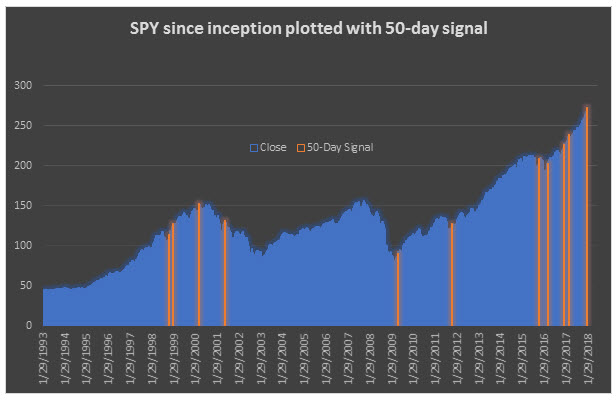Rare SPY Signal Suggests Stocks Could Cool Off
After the strongest start to a calendar year in over a decade, U.S. stocks are largely overbought. What's more, the SPDR S&P 500 ETF Trust (SPY) -- which moves in step with the broader S&P 500 Index (SPX) -- is sending up a technical signal that flashed just once in 2017, according to data from Schaeffer's Quantitative Analyst Chris Prybal. Below, we take a look at these rare SPY signals, and what it could mean for the stock market in the short term.
Specifically, the SPY on Friday closed more than 10 points above its 50-day moving average. Counting one signal every two months, the last time this happened was in early March 2017, and last week's signal was just the 11th ever for the SPY since 1993.


Digging deeper into the data, the SPY has underperformed in the short term following previous signals. One week later, the exchange-traded fund (ETF) was 1.29% lower, on average, with a win rate of just 20%. That's compared to an average anytime one-week gain of 0.17%, with a positive rate of 57%, looking at data since 1993.
One month after a signal, the SPY was down 1.67%, on average, and higher just half that time. That's compared to an average anytime one-month gain of 0.7%, with a win rate of 63%. And while the SPY was in the black three months after a signal -- 70% of the time, at least -- its average gain of 1.38% is smaller than usual. Since 1993, the SPY has averaged a three-month gain of 2.09%.
Only six months after a signal is the SPY "back to normal." The fund was up 4.7%, on average -- slightly better than its average anytime six-month gain of 4.26%. Further, the SPY was higher 70% of the time six months out, in line with its anytime six-month win rate of 73%.

As Prybal notes,these signals seem to precede either "relief rallies" during downturns, or extreme euphoria during upturns. That would echo the recent American Association of Individual Investors (AAII) weekly survey. The percentage of bullish respondents increased last week to nearly 60% from 52%, pushing the four-week moving average of the bullish contingent to the third highest reading since 2010. In the two previous instances since 2010 that the bullish percentage spiked this high, sideways action followed, prior to an eventual stock market sell-off, as Schaeffer's Senior V.P. of Research Todd Salamone noted this week.
Should the SPY pull back in the near term, however, Salamone noted that the $266-$268.50 neighborhood would be the "first line of defense." This region is home to SPY's 20-day moving average, itsmid-December Fed Day closing level ($266.75), and $268.40, or four times its March 2009 low close. The 2017 close of $266.86 is also in this vicinity.